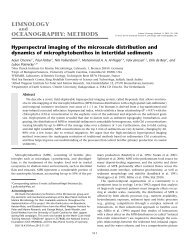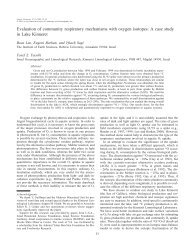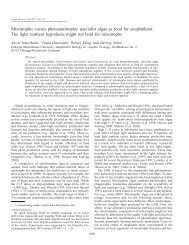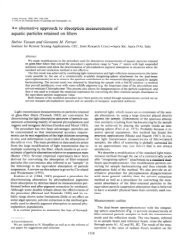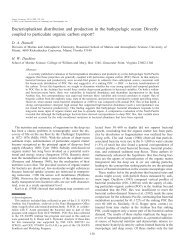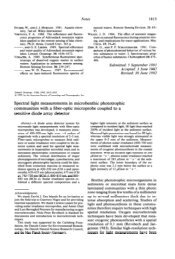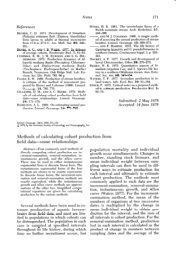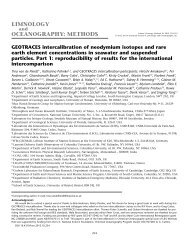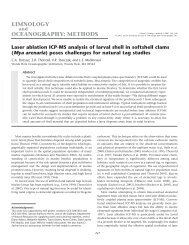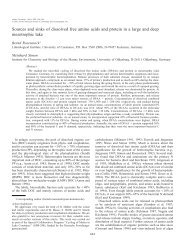Download - ASLO
Download - ASLO
Download - ASLO
You also want an ePaper? Increase the reach of your titles
YUMPU automatically turns print PDFs into web optimized ePapers that Google loves.
1770 Notes<br />
r=0.15<br />
(typ.)<br />
‘F q-<br />
El<br />
_<br />
I<br />
/‘ ‘\,<br />
+45cm+<br />
/F$2+.,<br />
\<br />
3.3cm<br />
T=T<br />
Bottom surface sanded<br />
to adjust weight<br />
to 30 f 1.5 g<br />
Fig. 1. Dimensions of the clod cards.<br />
cording to the methods of Doty (197 1) and<br />
Howerton and Boyd (1992), except that neither<br />
the starting plaster of paris nor the finished<br />
cards were oven-dried before use. Our clod<br />
cards were made from reagent-grade plaster of<br />
paris (calcium sulfate hemihydrate, EM Science<br />
Co.) with 335 ml of water per 500 g. We<br />
slowly added plaster of paris to the water<br />
as we stirred it with a spoon; we poured the<br />
slurry into flexible plastic ice-cube trays and<br />
allowed it to harden for 20-30 min before removing<br />
the clod cards. We tapped the trays<br />
vigorously several times while the mixture was<br />
still liquid to dislodge air bubbles. Sometimes,<br />
a thin layer of liquid covered the surface of the<br />
hardening clod cards in the trays. This layer<br />
was decanted before the cards were removed.<br />
After removal, the cards were dried for 3 d or<br />
longer on a laboratory bench, and the bottoms<br />
were sanded until the cards had uniform weight<br />
within a batch (within 1.5 g); they were then<br />
glued to 5- x 7-cm sheets of waterproof plastic<br />
(Nalgene PolyPaper) with silicone cement.<br />
Weight loss due to water exposure was quantified<br />
by weighing dry clod cards before exposure,<br />
placing them in the test solution for<br />
24 h, allowing them to redry for 3 d or longer<br />
on a laboratory bench, and then reweighing<br />
them.<br />
The ice-cube trays used in these experiments<br />
produced clod cards of shape and dimensions<br />
shown in Fig. 1. Internally, the dry cards had<br />
a foam structure with numerous interconnected<br />
minute air spaces within the calcium sulfate<br />
matrix. The cards had densities of 1.19-l .21<br />
/<br />
at 25°C and weighed 28-32 g each. When placed<br />
in test solutions, the cards were fully saturated<br />
within 5 min, absorbing from 10 to 12 ml of<br />
solution.<br />
Water motion experiments were carried out<br />
inside a greenhouse in a shallow, wooden-sided,<br />
square tank (2.1 m long, 0.36 m deep) with<br />
a plastic liner (Fig. 2). The tank was filled with<br />
test solution to a depth of 25 cm (solution<br />
volume, 1.1 m3) and covered with sheets of<br />
Styrofoam to control temperature during each<br />
24-h run. Test solutions were chilled by circulating<br />
the water through a 124-W refrigeration<br />
unit with external thermostat by means<br />
of a 30-W circulation pump. Solutions were<br />
heated with a thermostat-controlled, 150-W<br />
immersion heater.<br />
Clod cards were attached at various positions<br />
along a 2-m stainless steel arm (1 cm<br />
thick) which was rotated in the tank at 2.4 rpm<br />
by a 37-W electric gear motor secured over the<br />
middle of the tank by an external wooden<br />
framework. The cards were mounted on the<br />
arm by attaching them with rubber bands to<br />
rigid PVC-plastic plates (5 x 7.5 cm, 0.3 cm<br />
thick) screwed to the arm. Five cards were<br />
mounted along each of the two radii at distances<br />
from the center of 7, 27,47,67, and 87<br />
cm. Thus, each position was represented by<br />
duplicate cards moving through the water at<br />
nominal velocities ranging from 1.8 to 2 1.8<br />
cm s-l, which are within the range of water<br />
velocities encountered on tropical reef flats<br />
(Glenn and Doty 1992) but lower than extreme<br />
tidal bores, which are up to 80 cm s-l (Mathieson<br />
et al. 1977). Greater velocities can be<br />
achieved by selecting a gear motor with a higher<br />
rotation rate (Howerton and Boyd 1992) or<br />
by using a longer rotating arm (Jokiel and Morrissey<br />
1993).<br />
Dissolution rates under free convection conditions<br />
were determined by suspending clod<br />
cards by wires 5 cm below the surface of 60<br />
liters of solution contained in ice chests. The<br />
ice chests were kept under constant temperature<br />
in an undisturbed indoor location during<br />
each 4-6-d run. The cards were withdrawn and<br />
weighed wet each day, then replaced in the<br />
chests.<br />
Three solutions were tested in the water motion<br />
tank: tapwater, brackish water, and seawater.<br />
Tapwater was from the Tucson municipal<br />
supply, and seawater was collected from




